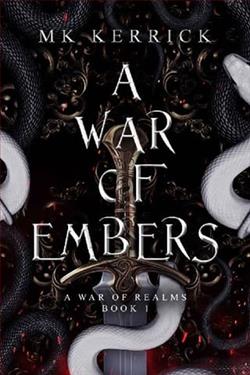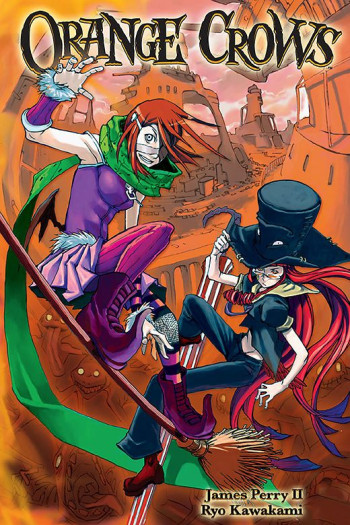Summary

A War of Embers
by M.K. Kerrick
Keres Anderson, the Slayer of Cinnabar, is seeking death.
Haunted by four souls trapped in her body, each more vicious than the next, she remembers only pieces of her life through her nightmares. Alone in her thoughts, she wages death is a kinder fate than the massacres she creates under the reigning queen, Lady Gwenyth.Bound into servitude, unsure of her crimes, Keres doles out punishments to the citizens of Cinnabar, apathetic to the mortals surrounding her.One quiet leap into what was thought to be salvation, leads to a darker entity than the one she fled.Rowan, Lord of Shadows, is a beast in human form. Willing to bargain with Keres for a price. She may have her death but only on his terms. And the Lord of Shadows isn't keen on letting Keres secrets escape her knowledge.Secrets, love, and war lies ahead. But the initial question will Keres choose to live or die when she finds her truth?
.
Read
A War of Embers on http://kissnovel.net
Martial Peak Reviews
A War of Embers by M.K. Kerrick is a hauntingly beautiful tale that delves into the complexities of identity, trauma, and the struggle for redemption. Set against the backdrop of a war-torn realm, the story follows Keres Anderson, known as the Slayer of Cinnabar, who is ensnared in a web of servitude and dark magic. The narrative is rich with emotional depth, exploring Keres' internal battles as she grapples with her past and the monstrous legacy that haunts her.
The blurb sets the stage for a gripping journey, introducing Keres as a character tormented by the souls of her victims, each vying for dominance within her. This unique premise immediately draws readers into her psyche, making them question the nature of her existence and the morality of her actions. The author skillfully portrays Keres' apathy towards the citizens of Cinnabar, a reflection of her own disconnection from her humanity. This theme of isolation resonates throughout the novel, as Keres navigates a world where she is both a weapon and a pawn, bound to the whims of the ruthless Lady Gwenyth.
Kerrick's character development is one of the novel's strongest aspects. Keres is not merely a one-dimensional anti-hero; she is a complex individual shaped by her experiences and the burdens she carries. As the story unfolds, readers witness her gradual transformation from a figure seeking death to one who must confront her past and the choices that led her to this point. The introduction of Rowan, the enigmatic Lord of Shadows, adds another layer of intrigue. His character serves as both a catalyst for Keres' journey and a reflection of her inner turmoil. Their interactions are charged with tension, as Rowan offers Keres a chance at freedom but at a steep price—her secrets. This dynamic creates a compelling push-and-pull that keeps readers engaged, as they wonder whether Keres will ultimately choose to embrace life or succumb to the darkness that beckons her.
The themes of love and sacrifice are intricately woven into the narrative. Keres' relationships with other characters, particularly with Rowan, challenge her understanding of trust and vulnerability. The author deftly explores the idea that love can be both a source of strength and a weapon of destruction. As Keres begins to unravel the truth about herself and her past, she must confront the possibility that love may be the key to her salvation. This exploration of love is not limited to romantic entanglements; it extends to the bonds of friendship and loyalty, highlighting the importance of connection in a world rife with chaos.
Another significant theme in A War of Embers is the concept of choice and agency. Keres is initially portrayed as a puppet, manipulated by those in power. However, as she gains insight into her own abilities and the truth of her existence, she begins to reclaim her agency. This journey is empowering and resonates with readers who have faced their own struggles for autonomy. Kerrick's portrayal of Keres' evolution is both inspiring and relatable, making her a character that readers can root for, despite her flaws.
The world-building in the novel is equally impressive. Kerrick crafts a vivid and immersive setting, filled with rich descriptions that bring the realm of Cinnabar to life. The dark, oppressive atmosphere mirrors Keres' internal struggles, creating a cohesive narrative that draws readers deeper into the story. The author’s attention to detail enhances the reading experience, allowing readers to fully engage with the world and its inhabitants. The political intrigue and the looming threat of war add a sense of urgency to the plot, propelling Keres forward on her quest for truth and redemption.
While the novel excels in many areas, it is not without its challenges. Some readers may find the pacing uneven at times, particularly in the early chapters where Keres' internal monologue can feel repetitive. However, this introspection is essential for understanding her character and the weight of her burdens. As the story progresses, the pacing picks up, leading to a thrilling climax that leaves readers breathless.
In comparison to other works in the fantasy genre, A War of Embers stands out for its psychological depth and character-driven narrative. Fans of authors like Sarah J. Maas and V.E. Schwab will appreciate Kerrick's ability to blend dark themes with moments of hope and resilience. The exploration of moral ambiguity and the consequences of one's choices echoes the complexities found in works like A Court of Thorns and Roses and The Shades of Magic series, making this novel a worthy addition to the genre.
In conclusion, M.K. Kerrick's A War of Embers is a powerful exploration of identity, trauma, and the quest for redemption. With its richly developed characters, intricate world-building, and thought-provoking themes, the novel captivates from start to finish. Keres Anderson's journey is one of self-discovery and resilience, inviting readers to reflect on their own choices and the nature of their humanity. This book is a must-read for anyone seeking a dark yet hopeful tale that lingers long after the final page is turned.
























Reviews 0
Post a Reviews: